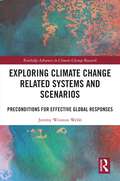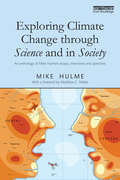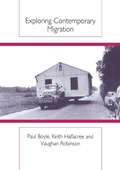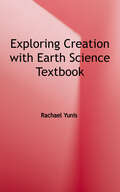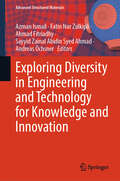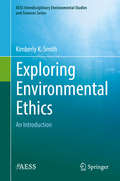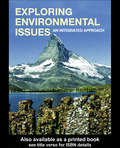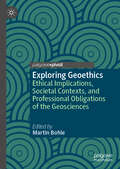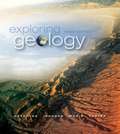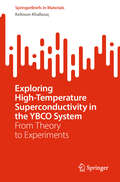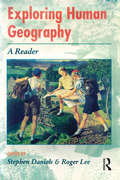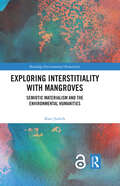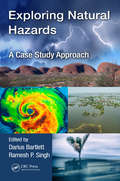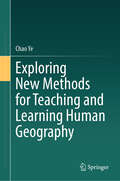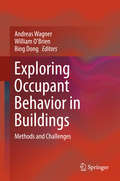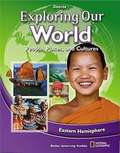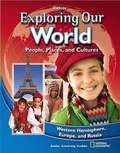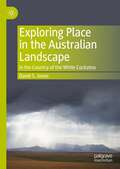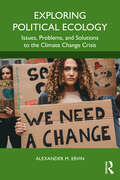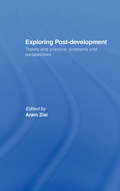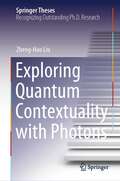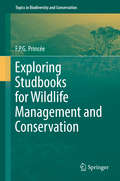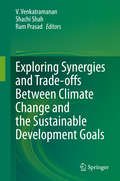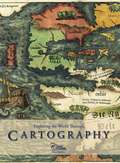- Table View
- List View
Exploring Climate Change Related Systems and Scenarios: Preconditions for Effective Global Responses (Routledge Advances in Climate Change Research)
by Jeremy Winston WebbJeremy Webb draws on multiple disciplines to piece together the climate change puzzle, identifying what it would take to limit climate change and its impacts.The book starts with a summary of the climate change problem and develops a Climate Change, National Interests, International Cooperation (CCNIIC) model of the climate response system. Webb reviews ‘reverse stress testing’, ‘backcasting’, and ‘theory of change’ methods, showing how they can be used to collect a large sample of possible futures. He also shows how we can explore the multiverse of futures using a new method called thematic chain analysis, finding relevant connections across scenarios. In the second half of the book, Webb explores 175 scenarios collected through 27 interviews with climate change experts. From these scenarios a signal response model is developed. Preconditions for effective social change and behaviour, political will and policy, as well as business and economic activity are synthesised. Lessons include preconditions for effective global responses to climate change, showing what it takes to limit climate change and related impacts. The book finishes with an epilogue, applying the signal response model and preconditions for effective global responses to COVID-19, demonstrating that models from this book can be applied to other global response problems – and used to quickly assess possible response strategies.This book will be of great interest to students and scholars of climate change, environmental policy and future studies.
Exploring Climate Change through Science and in Society: An anthology of Mike Hulme's essays, interviews and speeches
by Mike HulmeMike Hulme has been studying climate change for over thirty years and is today one of the most distinctive and recognisable voices speaking internationally about climate change in the academy, in public and in the media. The argument that he has made powerfully over the last few years is that climate change has to be understood as much as an idea situated in different cultural contexts as it is as a physical phenomenon to be studied through universal scientific practices. Climate change at its core embraces both science and society, both knowledge and culture. Hulme’s numerous academic and popular writings have explored what this perspective means for the different ways climate change is studied, narrated, argued over and acted upon. Exploring Climate Change through Science and in Society gathers together for the first time a collection of his most popular, prominent and controversial articles, essays, speeches, interviews and reviews dating back to the late 1980s. The 50 or so short items are grouped together in seven themes - Science, Researching, Culture, Policy, Communicating, Controversy, Futures - and within each theme are arranged chronologically to reveal changing ideas, evidence and perspectives about climate change. Each themed section is preceded with a brief introduction, drawing out the main issues examined. Three substantive unpublished new essays have been specially written for the book, including one reflecting on the legacy of Climategate. Taken as a collection, these writings reveal the changes in scientific and public understandings of climate change since the late 1980s, as refracted through the mind and expression of one leading academic and public commentator. The collection shows the many different ways in which it is necessary to approach the idea of climate change to interpret and make sense of the divergent and discordant voices proclaiming it in the public sphere.
Exploring Contemporary Migration
by Paul Boyle Keith Halfacree Vaughan RobinsonExploring Contemporary Migration provides the first comprehensive introduction to the various aspects of population migration in both the developed and the developing worlds. Some of the most important quantitative and qualitative methods used for the description and analysis of migration are presented in a clearly structured and accessible way. The various theoretical approaches used to explain the complex patterns of migration are also summarised. These patterns are then explored through the use of specific migration-related themes: employment, stage in the life course, quality of life, societal engineering, violence and persecution, and the role of culture.Exploring Contemporary Migration is written in a user-friendly, accessible style, appealing to undergraduate students of population geography and social science students taking a population module. This text will also be valuable reading to those researchers and academics concerned with gaining a broad understanding of the dynamics and patterns of contemporary population.
Exploring Creation with Earth Science
by Rachael YunisLet’s dig in the dirt, not just talk about it. What is it? How did it get made? Why is it different depending on where you dig? What will you find living in it? <p><p> Let’s realize that we don’t get deliveries from outer space so everything we need, literally everything, is given to us and made fresh with the systems created to keep life forms alive throughout time. How does the Earth replenish its resources again, and again, and again? Join us in Exploring Creation with Earth Science and find out! <p><p> Your young explorer will begin this course with an overview of our cosmic address in the observable universe and then grow in knowledge of what, in the entire universe, makes Earth special and capable of sustaining life. <p><p> An awareness of the world will develop as students interact with the Earth’s geosphere, hydrosphere, atmosphere, and biosphere. By digging deeper into the many different layers of the Earth and the cycles that renew the face of the Earth, your student will acquire not only wisdom that will endure for a lifetime but also an appreciation for our Creator.
Exploring Diversity in Engineering and Technology for Knowledge and Innovation (Advanced Structured Materials #215)
by Andreas Öchsner Azman Ismail Fatin Nur Zulkipli Ahmad Fitriadhy Sayyid Zainal Abidin Syed AhmadThis book offers research result which covers a wide range of topics, including sediment transportation in rivers, efficient adsorption processes, renewable energy, structural resilience, and environmental studies. Researchers explore various areas, including the stability of fishing vessels, the impact of mining on riverbeds, traditional navigation methods, medical procedures, advanced materials, and the utilization of artificial intelligence in data analysis. These comprehensive papers also address structural analysis, chloride-induced damage assessment, and the potential of soy biodiesel in marine engines. It concludes with discussions on probabilistic models, sustainable aquaculture, planning for renewable energy, and the integration of technology in environmental monitoring. This diverse compilation underscores the unwavering pursuit of knowledge and innovation across scientific and engineering disciplines, offering promise for a brighter and more technologically advanced future.
Exploring Environmental Ethics: An Introduction (Aess Interdisciplinary Environmental Studies And Sciences Ser.)
by Kimberly K. SmithThis book is designed as a basic text for courses that are part of an interdisciplinary program in environmental studies. The intended reader is anyone who expects environmental stewardship to be an important part of his or her life, as a citizen, a policy maker, or an environmental management professional. In addition to discussing major issues in environmental ethics, it invites readers to think about how an ethicist's perspective differs from the perspectives encountered in other environmental studies courses. Additional topics covered include corporate social responsibility, ecological citizenship, property theory, and the concept of stewardship as a vocation.
Exploring Environmental Issues: An Integrated Approach
by David D. KempGlobal warming, ozone depletion, drought, acid rain - their causes are viewed as extraordinarily complex; their effects are assumed catastrophic. Exploring Environmental Issues provides a key to understanding our potential crisis. The concise, introductory text presents a review of current environmental issues using a geographical approach that stresses the interrelationships between environment and societies.This user-friendly volume is an essential book for students and all who are concerned with the nature of contemporary environmental issues. Information is presented in a refreshing manner utilising over 170 figures and 50 photographs. Global boxed case studies are used throughout to highlight and explore issues in more detail. The text also contains discussion points, annotated further reading and an extensive glossary.
Exploring Geoethics: Ethical Implications, Societal Contexts, and Professional Obligations of the Geosciences
by Martin BohleThis book explores the potential of geoethics, as designed within the operational criteria of addressing the deeds and values of the human agent as part of the Earth system. It addresses three key questions: i) what should be considered 'geoethics' in an operational sense, ii) what is peripheral to it, and iii) is there a case therefore to establish a denomination, such as geo-humanities or geosophy, to capture a broader scope of thinking about geoscience and its interactions with society and the natural world, for the benefit of the geo-professionals and others.The book begins by framing, contextualising and describing contemporary geoethics, then goes on to cover several examples of geoethical thinking and explores the societal intersections of geosciences in the planetary ‘human niche’. The concluding chapter discusses the challenges facing the emerging field of geoethics and how it may evolve in the future. Bringing together a set of experts across multiple interdisciplinary fields this collection will appeal to scholars, researchers, practitioners and students within geosciences and social sciences, political sciences as well as the humanities. It will interest those who are curious about how ethical reflections relate to professional duties, scholarly interests, activities in professional geoscience associations, or responsible citizenship in times of anthropogenic global change.
Exploring Geology (Third Edition)
by Stephen Reynolds Charles M. Carter Julia Johnson Paul MorinExploring Geology by Reynolds/Johnson/Kelly/Morin/Carter is an innovative textbook intended for an introductory college geology course, such as Physical Geology. This ground-breaking, visually spectacular book was designed from cognitive and educational research on how students think, learn, and study. Nearly all information in the book is built around 2,600 photographs and stunning illustrations, rather than being in long blocks of text that are not articulated with figures. These annotated illustrations help students visualize geologic processes and concepts, and are suited to the way most instructors already teach. To alleviate cognitive load and help students focus on one important geologic process or concept at a time, the book consists entirely of two-page spreads organized into 19 chapters. Each two-page spread is a self-contained block of information about a specific topic, emphasizing geologic concepts, processes, features, and approaches. These spreads help students learn and organize geologic knowledge in a new and exciting way. Inquiry is embedded throughout the book, modeling how geologists investigate problems. The title of each two-page spread and topic heading is a question intended to get readers to think about the topic and become interested and motivated to explore the two-page spread for answers. Each chapter is a learning cycle, which begins with a visually engaging two-page spread about a compelling geologic issue. Each chapter ends with an Investigation that challenges students with a problem associated with a virtual place. The world-class media, spectacular presentations, and assessments are all tightly articulated with the textbook. This book is designed to encourage students to observe, interpret, think critically, and engage in authentic inquiry, and is highly acclaimed by reviewers, instructors, and students.
Exploring High-Temperature Superconductivity in the YBCO System: From Theory to Experiments (SpringerBriefs in Materials)
by Keltoum KhallouqThe book explores the properties and behaviors of high-critical-temperature superconductors in the yttrium barium copper oxide (YBCO) system, looking specifically at Y0.5Ln0.5BaSrCu3O6+z compounds, where Ln represents rare earth elements like europium (Eu), samarium (Sm), and (neodymium) Nd. Structured into several chapters, it navigates through key aspects of superconductivity and its characterization. Starting with an introduction to the discovery of high-critical-temperature superconductors and their far-reaching applications, it sheds light on unresolved questions in materials physics, particularly concerning the behavior of the copper(II)-oxide (CuO2) planes and the introduction of additional electronic holes. Emphasizing the pivotal role of the CuO2 planes in shaping material properties above the critical temperature, it also delves into the history of superconductivity, properties of superconducting materials, and various types of superconductors. Phenomenological theories like the London theory, Ginzburg-Landau theory, and Abrikosov's theory of the mixed state in type II superconductors are discussed, along with conventional theories such as the BCS theory and Josephson junctions. The book provides an overview of experimental techniques used to characterize structural, magnetic, and electrical properties of superconductor compounds, including X-ray diffraction, scanning electron microscopy, and magnetometry. Focusing on the structural, magnetic, and electrical properties of Y0.5Ln0.5BaSrCu3O6+z compounds, along with the effects of substitutions and thermal treatments, the book aims to achieve several objectives. These include a comparative study of superconducting and structural properties under various thermal treatments and isovalent substitutions, analysis of magnetic susceptibility and electrical resistivity as functions of temperature, investigation of the evolution of mixed-state properties with changing temperatures, and utilization of the Rietveld crystallographic refinement method to establish correlations between interatomic distances and critical temperatures. Additionally, the book presents the synthesis of studied compounds through solid-state reactions and subsequent thermal treatments, including annealing under oxygen and argon atmospheres. The results of these treatments are discussed in relation to improvements in irreversibility lines, magnetic shielding, and grain quality.
Exploring Human Geography: A Reader (Arnold Readers in Geography)
by Roger Lee Stephen DanielsA lively and stimulating resource for all first year students of human geography, this introductory Reader comprises key published writings from the main fields of human geography. Because the subject is both broad and necessarily only loosely defined, a principal aim of this book is to present a view of the subject which is theoretically informed and yet recognises that any view is partial, contingent and subject to change.The extracts selected are accessible and raise issues of method and theory as well as fact. The editors have chosen articles that not only represent main currents in the present flow of academic geography but which are also responsive to developments outside of the discipline. Their selection contains a mixture of established and recent writings and each section features a contextualizing introduction and detailed suggestions for further reading.
Exploring Interstitiality with Mangroves: Semiotic Materialism and the Environmental Humanities (Routledge Environmental Humanities)
by Kate JudithMangroves thrive in intertidal zones, where they gather organisms and objects from land, river, and ocean. They develop into complex ecologies in these dynamic in-between spaces. Mobilising resources drawn from semiotic materialism and the environmental humanities, this book seeks a form of social theory from the mangroves; that is to think interstitiality from the perspective of mangroves themselves, exploring the crafty and tenacious world-making they are engaged in. Three sections weave together theory, science and close observation, responding to calls within the environmental humanities for detailed attention to interactions in marginal spaces and those of interpretative tension. It examines interstitiality by considering theories of difference, relationality, and reflexivity in the context of mangrove socioecological materialities, drawing on influential writers such as Michel Serres, Jacques Derrida, Deborah Bird Rose, Donna Haraway, Brian Massumi and Maurice Merleau-Ponty as theoretical touchstones. Exploring Interstitiality with Mangroves is a lyrically crafted philosophical analysis that will appeal to scholars, researchers and students interested in the developing frontiers of more-than-human post-anthropocentric writing, theory and methodologies. It will be of interest to readers in ecocriticism, environmental humanities, cultural geography, place studies and nature writing.
Exploring Natural Hazards: A Case Study Approach
by Ramesh Singh Darius BartlettThe Sendai Framework for Disaster Risk Reduction 2015–2030 has identified four priority areas for Disaster Risk Reduction: understanding disaster risk; strengthening disaster risk governance to manage disaster risk; investing in disaster risk reduction for resilience and enhancing disaster preparedness for effective response; and to "Build Back Better" in recovery, rehabilitation and reconstruction. Although tremendous progress has been made in recent decades in understanding the workings of the Earth systems and, in particular, its impacts on and responses to human actions, there remains a continuing and pressing need for knowledge that will allow society to simultaneously reduce exposure to global environmental hazards, while also meeting economic development goals. Exploring Natural Hazards: A Case Study Approach, contributes to the knowledge showcasing advanced practices for the monitoring of natural hazards. Through each case study, the book examines mainly hazards arising from processes within the hydrosphere and atmosphere, triggered or exacerbated by inputs to and transfers of energy between environmental components. It discusses the causes of these phenomena, and ways in which improved policy making, sometimes coupled with the application of appropriate modern technologies, can help to reduce people’s exposure to harm. Discussing challenges, lessons learned and recommendations, this book provides a snapshot of issues related to tropical cyclones and typhoons, desertification, floods, lightning as a hazard and the need for alert systems. It is a valuable resource for practitioners and professionals alike, for researchers, students and others who work at the intersection between environmental hazards, sustainable development and social justice.
Exploring New Methods for Teaching and Learning Human Geography
by Chao YeThis book proposes a new and central teaching concept "we are all makers" and innovates the geographical teaching modes and methodology. Geography teaching, especially how to teach geographical thinking, is important and related to the development of the discipline. In this field, the exploration of new teaching methods in non-English speaking countries and regions still needs to grow. Based on the author's experience of teaching geographical thinking and human (cultural) geography for more than ten years, the book links geographical thinking to the realistic cases with new social media tools such as WeChat APP and blog. Under the guidance of these new methods, such as poem, emotional, couplet game, keywords, blog-based teaching, and the like, students are transformed from passive recipients of knowledge to active learners and even creators in the end. The book, which focuses on and pioneers new teaching methodology or methods, is used as a reference by scholars, researchers, practitioners, and readers specialized in fields such as geography, education, and pedagogy.
Exploring Occupant Behavior in Buildings
by Andreas Wagner William O’brien Bing DongThis book is the first to comprehensively cover research methods for building occupant behavior. As this is of growing importance for building design and for building performance optimization, the book aims to provide a sound scientific basis for experimental studies in this field. It introduces the reader to fundamental questions about the topic and unfolds the different fields related to occupant actions and comfort. This is followed by more general questions about developing an appropriate research method and experimental design. A comprehensive overview of sensors for monitoring environmental and also behavioral and action-related quantities helps to set up an experiment. In this context, different experimental environments and data collection methods (in-situ, laboratories, surveys) are introduced and discussed in terms of their suitability for the respective research question. Furthermore, data management and reporting is addressed. The book concludes with fundamental challenges in conducting occupant studies, with chapters on ground truth, ethics and privacy.
Exploring Our World: Eastern Hemisphere
by Richard G. Boehm Francis P. Hunkins David G. ArmstrongAn updatedmiddle school program co-authored by National Geographic,Exploring OurWorldintroduces students to an enriched view of theinterrelationships of geography, history, economics, government, citizenship,and current events--in one compelling package. Suitable for World Geography or World Cultures. A strong geographic thread isinterwoven with history, government, economics and culture to analyze differentregions of the world and issues facing the regions. Exploring Our World isavailable as a full survey or Western Hemisphere, Europe, and Russia and EasternHemisphere.
Exploring Our World: Western Hemisphere, Europe, and Russia
by Richard G. Boehm Francis P. Hunkins David G. ArmstrongWorld geography, world cultures�a world students can understand Exploring Our World: Western Hemisphere, Europe, and Russiais a middle school program co-authored by National Geographic. This program introduces students to an enriched view of the interrelationships of geography, history, economics, government, citizenship, and current events�in one compelling package. A strong geographic thread is interwoven with history, government, and current events to analyze different regions of the world and the issues they face. Suitable for a world geography or world cultures class, this program is also available as a full survey and Eastern Hemisphere. .
Exploring Place in the Australian Landscape: In the Country of the White Cockatoo
by David S. JonesIncluded is a deep ethno-ecological and cross-cultural translation, that takes the reader through both the Western understanding of sense of place as well as the Australian Aboriginal understanding of Country. Both are different intellectual constructions of thoughts, values and ideologies, but which share numerous commonalities due to their archetypal meanings, feelings and values transmitted to humans.
Exploring Political Ecology: Issues, Problems, and Solutions to the Climate Change Crisis
by Alexander M. ErvinThis book explores some of the conditions and underlying causes of the multiple environmental crises facing humanity. Rooted in anthropology, but multidisciplinary in scope, it surveys the many socio-cultural and socio-economic errors, foibles, and follies that brought us to these circumstances. Crucially and uniquely, it outlines an array of viable and practical solutions, some of which are radically different from the current status quo and cultural expectations. The first chapter canvasses the emerging, interdisciplinary field of political ecology, then Part I examines details and trends in agriculture. Part II portrays the threats posed by carbon dependent and combustive technologies as well as the hydro and nuclear energy systems now powering the majority of human actions in developed parts of the world and expanding beyond. The third part turns to consider solutions, including green new deals, de-growth policies, localization, agroecology, alternative energy systems, and many more possibilities. The conclusions engage with urgent moral and legal issues and outline social movement strategies—all related to our collective neglect of climate change—and then finally speculate upon possible futures. This book is key reading for researchers and students interested in climate change across the social and physical sciences and humanities.
Exploring Post-Development: Theory and Practice, Problems and Perspectives (Routledge Studies in Human Geography)
by Aram ZiaiTackling issues surrounding post-development which is arguably one of the most significant debates in the field of north-south relations at the beginning of the twenty-first century. Contributors explore the possibilities and limitations of post-development theory and practice drawing on empirical studies of movements and communities in several continents.
Exploring Quantum Contextuality with Photons (Springer Theses)
by Zheng-Hao LiuThis thesis highlights research explorations in quantum contextuality with photons.Quantum contextuality is one of the most intriguing and peculiar predictions of quantum mechanics. It is also a cornerstone in modern quantum information science. It is the origin of the famous quantum nonlocality and various nonclassical paradoxes. It is also a resource for many quantum information processing tasks and even universal quantum computing. Therefore, the study of quantum contextuality not only advances the comprehension of the foundations of quantum physics, but also facilitates the practical applications of quantum information technology.In the last fifteen years, the study of quantum contextuality has developed from a purely theoretical level to a stage where direct experimental tests become amenable. However, the experimental research on contextuality at the current stage largely focuses on direct validations of some most famous predictions of contextuality, while other forms of contextuality and its practical applications in quantum information science are rarely involved. The research in this thesis is committed to bridge this gap from two directions: (1) to construct and test stronger forms of contextuality and relieve the requirements of contextuality experiments on experimental platforms, and (2) to explore the connections between contextuality and the other concepts in quantum information science and directly demonstrate the application of contextuality in broader scenarios. Specifically, the thesis have discussed the research topics about the relationship between quantum contextuality and nonlocality, the “all-versus-nothing” paradoxes from quantum contextuality, the ore- and post-selection paradoxes from quantum contextuality, and the topological protection and braiding dynamics of quantum contextuality in quasiparticle systems.
Exploring Studbooks for Wildlife Management and Conservation (Topics in Biodiversity and Conservation #17)
by F.P.G. PrincéeMany endangered species of wild animals are managed in captivity through studbooks. In this book these data-rich resources are mined in innovative, integrated and statistically tested ways to maximise information gain for conservation practice – whether for captive or released/reintroduced or managed wild populations. This book is thus an important tool for all species managers, and for students and researchers in small population biology and wildlife conservation.The book's studbook analyses are grouped in three interrelated sections: natural history, demography and genetics. Statistical tests to determine the significance of results or to compare results between subgroups are undertaken throughout. Real studbooks of a variety of species, e.g. cranes, wolverines, blesbok, illustrate the practical applications and interpretations of the analyses and statistics. The “natural history” section presents analyses to determine baseline species information such as litter size, inter-birth interval, longevity and seasonality. “Demography” covers census(-style) analyses, age-class based life tables, comparative survival analyses and population projections. Solutions for dealing with small sample sizes are included.Inbreeding depression and unconscious selection form the main focus of the “genetics” section. Survival and life table analyses are used to assess inbreeding effects. Quantitative genetics methods are applied to natural history traits as a tool to monitor genetic variation. A fourth section on “conservation” shows how data from captive populations can be used where natural history data from wild populations are missing. A real example uses studbook data to inform Population Viability Analysis. The final section deals with issues related to incomplete and missing data and statistical topics.The purpose-written open-source software programs “Population Management Library (PML)” and “studbookR” used for analyses in the book, are available at www.princee.com.
Exploring Synergies and Trade-offs between Climate Change and the Sustainable Development Goals
by Ram Prasad Shachi Shah V. VenkatramananThe existential environmental crisis prompted the United Nations to formulate the Millennium Development Goals at the turn of the 21st century in order to embark on an era of sustainable development. The progress and deficiencies in achieving the Millennium Development Goals provided impetus to the intelligentsia and policymakers to map out the pertinent goals for a sustainable growth trajectory for humanity and the planet. The United Nations’ 2030 Agenda for Sustainable Development, which was adopted in September 2015, took the shape of 17 Sustainable Development Goals (SDGs) and 169 targets. In effect, the 17 Sustainable Development Goals focus on protecting the earth's life support systems for intra- and inter-generational equity and for development that is rooted in sustainability science. Attaining these goals is an uphill task; nevertheless, scientific knowledge, trans and interdisciplinary inquiries, concerted global action and capacity building would provide an enabling environment for achieving the SDGs. This book explores the synergies and trade-offs between climate change management and other SDGs. It highlights the policy imperatives as well as the interrelations between combating climate change and its impacts (SDG 13) and food and nutritional security (SDG 2), water security (SDG 6), soil security (SDG 15), energy security (SDG 7), poverty eradication (SDG 1), gender equality (SDG 5), resilient infrastructure (SDG 9), and sustainable and resilient cities (SDG 11).
Exploring The World Through Cartography
by Classical MultiMediaExploring the World Through Cartography
